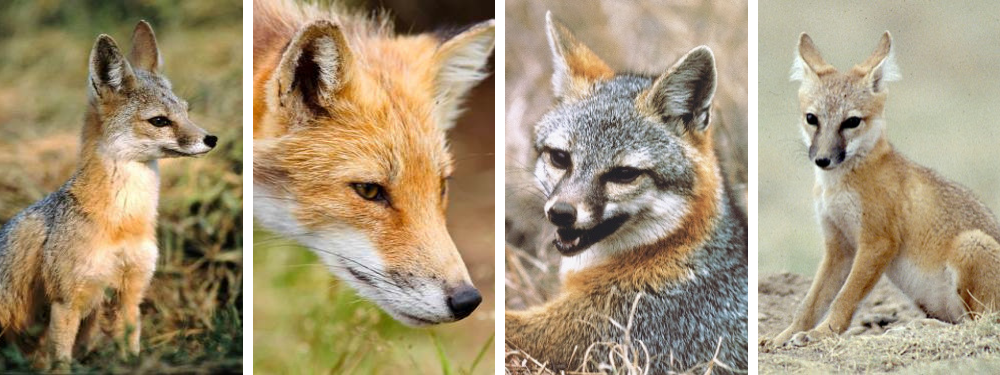
Left to right: kit fox, red fox, gray fox, swift fox
Foxes are members of the dog family but possess cat-like qualities, thus their young may be called pups or kits. There are 4 different fox species in Texas.
- The red fox was imported to train tracking dogs. Its many feline traits include elliptical pupils, kits that hiss like kittens, and it will arch its back and puff up when threatened. Most red foxes live in North Central Texas.
- The gray fox is the only fox that climbs trees. It will nap in the branches, travel through the tree canopy, and build a den high in a hollow. Gray foxes are found all over the state.
- The kit fox weighs only 3-6 lbs. Built for desert life, its yellowish coloring provides camouflage, and large ears help this tiny fox stay cool. Kit foxes live in the deserts of West Texas.
- The swift fox is similar to the kit fox, and only slightly larger. Once found in 77 counties, they're now in only 2, both in the Panhandle. Read more about swift and kit foxes in the magazine story, "The Other Foxes."
TPWD is working to learn more about swift and kit foxes. But finding a small fox isn’t easy, and we need your help. If you think you see one, report it on iNaturalist.

The agile Aplomado falcon had all but vanished from Texas by the 1930s, mainly due to loss of the prairie grassland they need to hunt. In 1986 this falcon was listed as an endangered species.
We and our partners, the Peregrine Fund and the U.S. Fish and Wildlife Service, began releasing Aplomado falcons in Texas in 1993. Knowing the birds wouldn't survive without their prairie habitat, we also worked to rebuild and maintain natural grasslands.
Mustang Island was an Aplomado falcon release area, and on June 1 this year two fuzzy falcon chicks were banded, the offspring of a wild Aplomado pair. A few days later, the 500th Aplomado falcon was banded in Texas. We'll continue working to restore these endangered birds so that future generations can also enjoy them. If you'd like to try to see the adult falcon pair, our press release has more information on where to find endangered Aplomado falcons on Mustang Island.
Draw in Pollinators with Horsemint

Horsemint is in abundance this year, and you may have seen its tall stems of purple flowers in roadside fields. You can grow horsemint almost anywhere with enough sun. It's a good cut flower, and best of all, hummingbirds, bees and butterflies are drawn to it.
Horsemint is also known as bee balm, due to its use as a salve for stings. It's sometimes called lemon mint, and Native Americans used it to make a lemony-mint tea to soothe sore throats. Add this native Texan to your garden this fall.
|